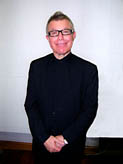Libeskind and the architecture of optimism
Libeskind and the architecture of optimism McGill University
User Tools (skip):
Libeskind and the architecture of optimism
Daniel Libeskind, the man who is designing the structures that will replace and commemorate the World Trade Centre in New York, believes architecture provides for far more than shelter.

Daniel Libeskind
Kirsten Anderson
"Without hope, architecture could not be practicable," Libeskind told a crowd of over 1,000 people packed into Leacock 132 for the second annual David J. Azrieli Lecture in Architecture. "We cannot afford the luxury of pessimism." Faith in the future characterizes Libeskind's work, expressed through his unique vision. Alberto Pérez-Gómez introduced the speaker as someone "whose work is the product of an ethos based in the amelioration of the human spirit," and the talk and slide show that followed provided ample illustration.
The architect himself is something of a case study in the benefits of the tangential line. "I didn't seek to become an architect," he said. "I just got on a path and followed it." Libeskind began his university studies in music, later switching to architecture and receiving his professional degree in 1970. But his explosion onto the international scene did not come until 1989, when he won the competition to design the Jewish Museum in Berlin, and subsequently formed his own professional practice. The museum, opened in 2001, features his characteristic oblique angles and surprising prospects — those features that Pérez-Gómez called the "saturation of perspectival devices."
In recent years, Libeskind has become as close to a pop star as one finds in the world of architecture. His presentation comprised a tour of his greatest hits, following on the heels of the September publication of his memoir Breaking Ground, as well as some of his minor gems, because, he explained, "It's good for students to see something small and doable." Among these more modest projects were the Studio Weill in Mallorca, Spain, his smallest project, completed in 2003; the Graduate Centre at the London Metropolitan University in North London, which won the Royal Institute of British Architects Award for 2004; and the Felix Nussbaum Haus in Osnabrück, Germany, which has the distinction of being Libeskind's first completed building, opened in 1998 and housing the art of the Jewish painter Nussbaum, who was executed in a concentration camp in 1944. "We built the interior of the Nussbaum Haus with as narrow a space as possible under German zoning laws, to capture the closeness of his hiding spaces during the War," he said. The architect also had sunflowers planted outside the museum — an unusual choice, he noted, as sunflowers die and look bleak. "We decided that would be part of the message. But the children of that town have formed a 'Sunflower Society' to describe what had happened there, so people would not ignore their history. I think this is a wonderful example of the impact architecture can have."
Other highlights among the greatest hits parade include the Imperial War Museum North in Manchester, England, completed in 2002, and of course his design for the Renaissance ROM in Toronto, an addition to the Royal Ontario Museum that is scheduled to open in 2006. This design emerged from a series of sketches projected through crystals, inspired by displays he saw in the entrance of the museum. "I panicked when I won the competition because I thought, 'How can I possibly make a building based on this drawing?'"
Despite his penchant for the unusual, Libeskind insists upon the accessibility of his work. "Architecture communicates through the ankle. If you don't feel it in the foot, you'll never know it in your mind," he explained. "I don't believe there is a distinction between form and function. It's easy to do architecture if you dispense with these words." While some people have categorized him as a deconstructionist, he resists the category. "I never thought the idea of deconstruction applied to architecture. I think I convinced Derrida of this," he said, recalling a meeting with the famous philosopher.
In February 2003 his Memory Foundation plans won the World Trade Centre Design Study competition; the centrepiece will be the 1,776-foot-tall Freedom Tower, embraced by a spiral of other buildings and several acres of public space. "It is my largest and most complex project," he told the audience. Libeskind and his parents arrived in New York by boat; he was 13 years old, and spoke only Polish. "But I never forgot what that skyline meant — it was a symbol of the dream of making something good happen," he said of his adopted home. That dream still seems to motivate Libeskind. "Architecture is more of a storytelling profession than a technical one," he said. "If it is profound and emotionally driven, it can touch the human spirit."
